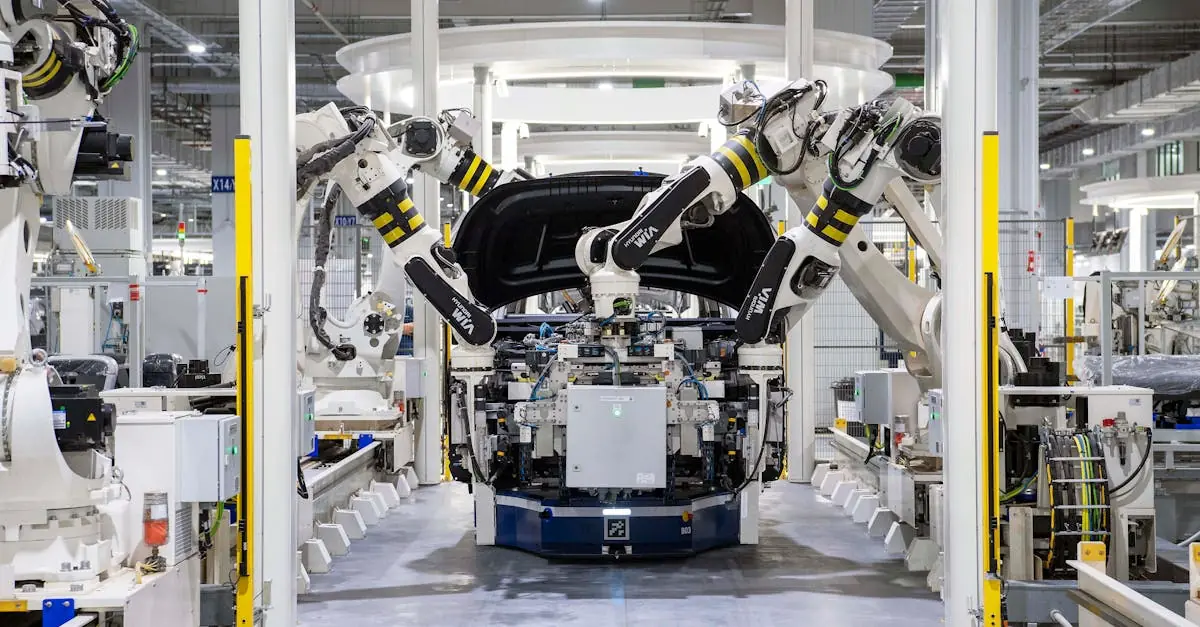In a world where machines are becoming the new coworkers, industrial automation and robotics are shaking things up faster than a coffee-fueled assembly line. Gone are the days of monotonous manual labor; today’s factories are buzzing with intelligent robots that can lift, sort, and even sashay their way through tasks. If you’ve ever dreamed of having a robot buddy to help you tackle the heavy lifting (or just keep you company during those long shifts), you’re not alone.
Table of Contents
ToggleOverview of Industrial Automation and Robotics
Industrial automation refers to the use of control systems and technologies to manage machinery, processes, and operations. This entails integrating robotics, artificial intelligence, and software to improve productivity and efficiency. Robotics plays a critical role in automating tasks traditionally performed by humans, particularly in repetitive or hazardous environments.
Factories employ various types of robots, such as articulated robots, collaborative robots (cobots), and autonomous mobile robots. Articulated robots excel in tasks like welding and painting because of their precision and flexibility. Cobots are designed to work alongside human workers, enhancing safety and productivity. Autonomous mobile robots transport materials within facilities, significantly reducing the need for manual labor.
The benefits of automation and robotics in industrial settings include increased accuracy and reduced operational costs. Businesses experience higher output and minimized errors, leading to enhanced product quality. Employees gain from having robotic coworkers handle strenuous tasks, allowing them to focus on more skilled activities. The collaboration between humans and robots fosters a safer working environment and improves job satisfaction.
Data shows that industries adopting robotics experience up to a 20% reduction in labor costs, while productivity increases by approximately 30%. Companies in manufacturing, logistics, and healthcare increasingly invest in automation technologies to stay competitive. As technology advances, ongoing innovations drive the development of smarter robots capable of performing complex tasks.
Adopting automation and robotics represents a significant shift in the industrial landscape, ensuring that organizations can meet growing demands while maintaining high standards. The integration of these technologies emphasizes the need for a workforce skilled in managing and maintaining advanced systems, thereby transforming job roles and skill sets across the sector.
Key Technologies in Industrial Automation
Industrial automation relies on several key technologies that drive efficiency and productivity in modern manufacturing processes. Among these are robotics systems and control systems, both crucial for enhancing operational capabilities.
Robotics Systems
Robotics systems include various types of robots, such as articulated robots, collaborative robots (cobots), and autonomous mobile robots. Articulated robots excel in precision tasks, often performing complex operations like welding and assembly. Cobots enhance human-worker productivity by supporting them in repetitive or heavy tasks. Autonomous mobile robots streamline material transport, ensuring efficient movement within facilities. Data from industries indicates that incorporating robotics can reduce labor costs by up to 30% while increasing output. These systems not only automate mundane tasks but also improve accuracy, leading to fewer errors and higher quality products.
Control Systems
Control systems manage machinery and operations with precision. Programmable logic controllers (PLCs) serve as the backbone of many industrial processes, allowing operators to automate machinery with ease. Supervisory Control and Data Acquisition (SCADA) systems further enhance monitoring capabilities, enabling real-time data analysis. With their ability to integrate robotics and artificial intelligence, control systems optimize processes for greater productivity. Studies show that integrating advanced control systems can increase operational efficiency by 25%. Enhanced control not only improves machine reliability but also leads to significant energy savings across operations.
Benefits of Industrial Automation and Robotics
Industrial automation and robotics bring numerous advantages to modern manufacturing environments. These technologies enhance productivity, streamline processes, and promote an agile workforce.
Increased Efficiency
Increased efficiency ranks among the leading benefits of industrial automation and robotics. Tasks that once required extensive labor now require fewer resources thanks to the speed and precision of robots. For instance, industries witness a 25% increase in operational efficiency after adopting robotics. Machines can operate continuously without breaks or fatigue, leading to higher output levels. When robots assist in assembly lines, human workers can engage in more complex, value-added activities. Consequently, organizations that implement automation achieve faster turnaround times and improved resource allocation.
Improved Safety
Improved safety remains a crucial advantage of implementing robotics in industrial settings. Robots take on dangerous tasks, significantly reducing workplace injuries. Statistics indicate that companies using robotics experience a drastic decline in accidents. Moreover, collaborative robots can work alongside human workers, enhancing safety protocols while maintaining productivity. Implementing automation leads to a safer working environment, where human workers can focus on oversight rather than hazardous tasks. As automation reduces potential hazards, employees achieve better job satisfaction, knowing that safety measures are prioritized.
Challenges Facing the Industry
Industrial automation and robotics face significant challenges that impact their implementation and effectiveness.
Integration Issues
Integration issues arise when new technologies interact with existing systems. Companies often encounter difficulties in connecting robotic systems with legacy equipment, which complicates the transition to automation. Customization of software and hardware becomes essential for seamless operation. Diverse industry standards further complicate the integration process by creating compatibility hurdles. Industry studies reveal that up to 45% of automation projects exceed their budget due to these challenges. Successful integration requires careful planning, skilled personnel, and innovative solutions to align older systems with cutting-edge robotics.
Workforce Displacement
Workforce displacement presents another challenge within the industrial automation landscape. Automating tasks previously performed by humans raises concerns about job security. Studies indicate that automation could displace around 20 million jobs globally by 2030. Many workers face the possibility of losing positions in favor of robots handling repetitive tasks. This shift leads to a pressing need for retraining and upskilling initiatives to prepare employees for new roles in automation management. By investing in education and training programs, companies can help their workforce adapt to this evolving environment and maintain productivity amidst these changes.
Future Trends in Industrial Automation and Robotics
Emerging technologies are set to redefine industrial automation and robotics. Trends indicate significant advancements in areas like artificial intelligence and cyber-physical systems that enhance productivity.
Artificial Intelligence
Artificial intelligence integrates deeply into industrial automation, driving improvements in decision-making and process optimization. AI algorithms analyze vast amounts of data in real-time, allowing for predictive maintenance and reducing downtime by up to 15%. Companies adopt AI-powered robots to adapt to dynamic production needs and improve the flexibility of manufacturing processes. Robotics systems equipped with AI can learn from their environments and optimize performance, enhancing overall efficiency and productivity.
Cyber-Physical Systems
Cyber-physical systems play a crucial role in the future of industrial automation. These systems combine physical processes with computational resources, creating smart factories where machines communicate seamlessly. They enable real-time monitoring and control, resulting in a 20% increase in operational efficiency. Implementing cyber-physical systems leads to improved coordination among machines, enhancing supply chain management and reducing operational costs. As industries embrace these advancements, they experience more cohesive and efficient production environments.
The future of industrial automation and robotics is undeniably bright. As these technologies continue to evolve they promise to reshape industries by enhancing efficiency and safety. Companies that embrace automation stand to gain a competitive edge by optimizing their operations and reallocating human resources to more skilled tasks.
While challenges like workforce displacement and integration issues remain significant addressing these concerns through retraining and strategic planning can lead to a more harmonious transition. The integration of AI and cyber-physical systems will further drive innovation creating smarter factories that adapt to changing demands.
Ultimately the journey towards automation is not just about replacing labor but about augmenting human capabilities and creating a more agile workforce ready to tackle the complexities of modern manufacturing.



